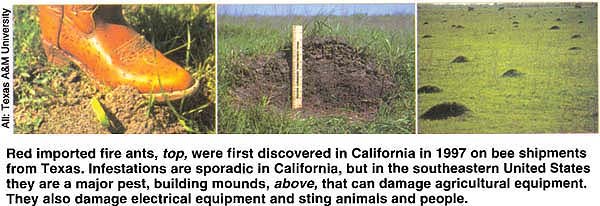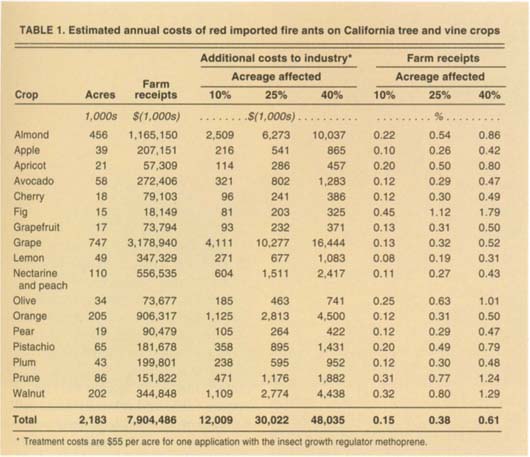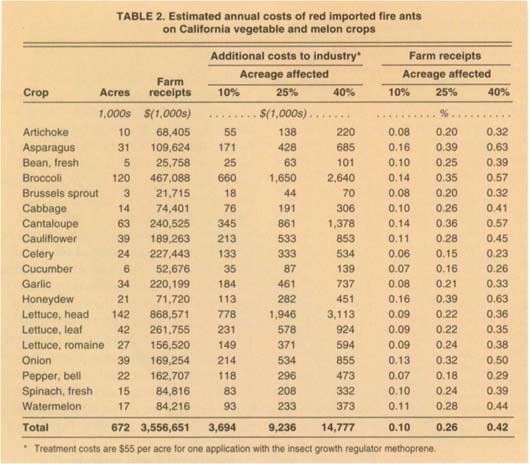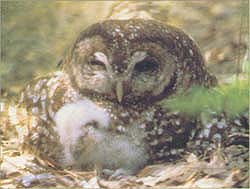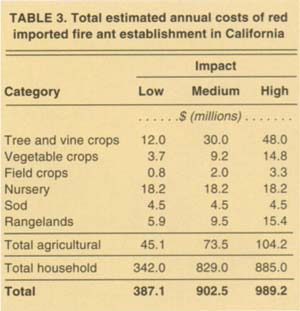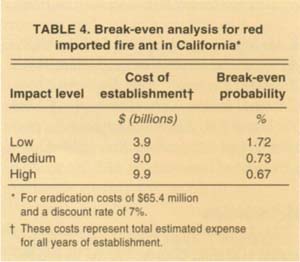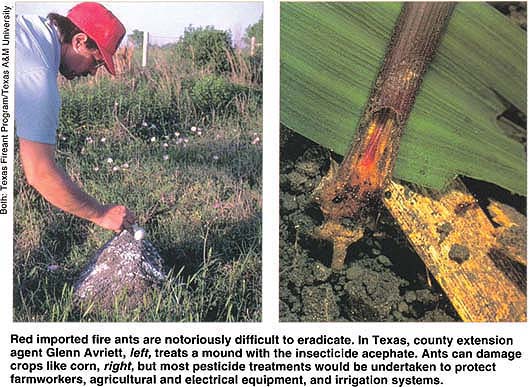All Issues
Eradication costs calculated: Red imported fire ants threaten agriculture, wildlife and homes
Publication Information
California Agriculture 56(1):26-34. https://doi.org/10.3733/ca.v056n01p26
Published January 01, 2002
PDF | Citation | Permissions
Abstract
The red imported fire ant, a pest newly introduced into California, threatens households, agriculture and wildlife. This study estimates the costs and benefits of a public program to eradicate the ants. The results show that almost all agricultural activities would be affected should the ants become established; however, households would incur the majority of costs. The total estimated cost if red imported fire ants become established would be between $387 million and $989 million per year in California. Given current funding levels for eradication of red imported fire ants, for the expected benefits to be at least as great as the expected costs, the probability of successfully eradicating the ants needs to be at least 0.65% if the annual costs of establishment are $989 million and 1.67% if they are $387 million.
Full text
The discovery in 1997 of the red imported fire ant in almond orchards in the San Joaquin Valley and, more recently, in many parts of Orange, Riverside and Los Angeles counties, has raised concerns about the effects of its recent introduction and potential spread throughout California. (In October 2001, red imported fire ants and mounds were discovered in Sacramento County. See p. 4 ). This pest is of particular significance because it threatens urban, agricultural and wilderness areas. Given the magnitude of the effects the ants have had in southern states, an examination of the potential costs to California should the ant become established is important in determining the appropriate policy response.
Red imported fire ants, top, were first discovered in California in 1997 on bee shipments from Texas. Infestations are sporadic in California, but in the southeastern United States they are a major pest, building mounds, above, that can damage agricultural equipment. They also damage electrical equipment and sting animals and people.
Due to its large populations and omnivorous diet, the red imported fire ant (Solenopsis invicta) can have a tremendous impact on rural and urban environments. Several hundred thousand worker ants live in large, mounded nests that can damage mowing and harvesting equipment. Cultivation of row crops destroys the mounds, but they may still form along field edges and in perennial crops such as tree fruits, nuts and grapes. The aggressive ants swarm out and sting humans or animals that disrupt their nests. In order to sting, they must first grab the skin with their mandibles for leverage, and then curl their abdomens to insert the stinger. The venom contains pi-peridines, which cause a burning sensation, and proteins, which can cause life-threatening anaphylactic shock in a small percentage (< 1%) of the population. Their sting causes a white pustule to form on the skin.
The ants are also known to cause extensive damage to irrigation lines. For unknown reasons, they aggregate near electrical fields where they can cause short circuits or interfere with switches and mechanical equipment such as water pumps, computers and air conditioners. Even more serious is when they infest traffic signals and airport landing lights. They also reduce biodiversity and threaten endangered species. Other species of ants, invertebrates and vertebrates are eliminated when they compete with red imported fire ants for limited resources.
We estimate that if the ants become established, the total costs (for all years of establishment) would be between $3.9 billion and $9.9 billion depending on how they adapt to the California environment. The costs are greater than those estimated for the establishment of other recently introduced pests, such as avocado thrips, and similar to the potential costs to California agriculture if the Mediterranean fruit fly became established (Coppock and Kreith 1999; Hoddle et al. in press).
A public program now under way to eradicate the ants may prevent, lessen or delay the projected losses. The total cost of the current program to taxpayers and the nursery industry is estimated at $65.4 million. Because there is some probability that the red imported fire ant eradication program will not be successful, the expected benefits need to be compared with the expected costs. The expected benefits or costs are equal to the total benefits or costs adjusted by the probability of success for the eradication program. The probability of successfully eradicating red imported fire ants needs to be at least 1.67% for the low-level damage estimate of $387 million per year and 0.65% for the high-level estimate of $989 million per year in order for the expected benefits to be greater than the expected costs.
Only the policy of total eradication, compared to allowing the ants to become established, is considered in this analysis. Other potential policies would be to contain the spread of the ants, to slow the rate of spread and establishment, or to invest in research on more effective pest controls, including biological controls. Obtaining appropriate estimates for these options is beyond the scope of this research at this time.
The ants arrive
Red imported fire ants originate from lowland areas of South America, and were most likely introduced into the United States around 1940. At that time several native fire ant species thrived in the Southeast and the presence of another exotic one created little concern. By the 1950s, however, their rapid spread (sometimes more than 100 miles per year) and more aggressive behavior alarmed the public. The ants' current geographic distribution includes all of the southern states from Florida to Texas, and as far north as southern Virginia, Tennessee, Arkansas and Oklahoma (fig. 1).
Although the U.S. Department of Agriculture and California Department of Food and Agriculture (CDFA) have maintained quarantines regulating the movement of soil, hay and equipment from regions inhabited by red imported fire ants, over the last 15 years they have been intercepted on numerous occasions at California border stations, and periodic outbreaks have occurred in several counties. The ants arrived on trucks, trains or other vehicles. In 1997, they were identified on bee shipments from Texas destined for almond orchards in the San Joaquin Valley.
Numerous colonies were detected in Orange and Riverside counties in October 1998. This was the first time the ants had been found on residential as well as commercial property. As a consequence, state and federal quarantines were imposed on all of Orange County, parts of Riverside County near Indio and Moreno Valley, and a small section of Los Angeles County. From the size and distribution of these infestations, it appears that red imported fire ants may have been established and spreading in the Trabuco Canyon area of Southern California for several years.
Fig. 1. Red imported fire ant quarantine areas in the United states, 2000. Source: USDA/Animal and Plant Health Inspection Service.
Fig. 2. Red imported fire ant (RIFA) colonization risk in California. Source: California Department of Food and Agriculture.
There is no way of predicting how far and how fast the ants will spread in California. Warm temperature and moisture are critical for their survival. Scarce water makes the desert regions of California inhospitable to the ants but, due to irrigation, they are able to thrive on golf courses, nurseries, horsefacilities and turf farms. The ants prefer to nest in moist soil often found in housing developments and irrigated farmland, or adjacent to watering holes on rangelands, lakes, ponds and streams. It is unlikely, however, that red imported fire ants could survive in the cooler climates of the Sierra Nevada and Northern California.
Estimating costs
Households, agriculture and wildlife are all affected by red imported fire ants. However, the costs and benefits of the ants' spreading throughout California would not be evenly distributed. Some households, farms or ranches could incur significant costs from large infestations, while nearby homes and agricultural operations may have little or no damage.
The costs estimated in this study are based on average costs from studies of damage by red imported fire ants in the southeastern United States. Since the ants are new to California, empirical values must be based on infestations elsewhere. These values are applied to the susceptible regions in California as determined by climatic factors and adjusted, where applicable, to account for low- and high-risk areas. Low-risk areas are along California's Central Coast, while high-risk areas are located in the Central Valley and Southern California (fig. 2).
Costs to urban households
The potentially serious effects of ants in urban areas include medical problems such as skin inflammations and allergic reactions to ant venom, reduced use of recreational facilities, damage to communications and electrical equipment, and the expense and indirect costs associated with increased use of pesticides (Dukes et al. 1999). Urban households can incur costs to treat mounds, repair damage to electrical equipment and pay medical and veterinary bills. For example, in South Carolina households, the average total annual cost per household due to the ants was $80 ($33 in low-risk areas and $104 in high-risk areas) (Dukes et al. 1999).
Given the wide range in costs in the South Carolina survey and climatic conditions in California, we used three methods to estimate the economic effects of red imported fire ant infestations on urban households. The first was to multiply the number of households in susceptible counties by the average cost per household for all households. The second method was to multiply the number of households in the low-risk counties by the average low-risk cost, and the number of households in the high-risk counties by the average high-risk counties cost, then add the two together. The third method was to multiply the number of households in susceptible counties by the average costs per low-risk household.
In 1999, the total number of California households in susceptible counties was 10,363,432 (DOF 2000). In the low-risk counties there were 2,711,036 households and in the high-risk counties 7,652,396. Total estimated cost of red imported fire ant damage to urban households is $829 million when average costs for all households are used to calculate the total, $885 million when cost is calculated by region, and $342 million when the average low-risk cost is used for all susceptible households.
Costs to agriculture
Tree crops and vineyards
Tree crops and vineyards use hand labor throughout the year for tasks such as pruning, raking and harvesting. In fields infested with the ants, crews may not be able to enter because of the ants' aggressive nature and painful stings, or they may request a higher fee to compensate for additional risks. Alternatively, producers could treat fields with insecticides and control red imported fire ants before crews enter. In our analysis, we assumed that producers would treat fields twice a year to control the ants with the insect growth regulator methoprene. Annual application costs were estimated at $55 per acre. While not included in this analysis, additional costs may accrue in order to meet quarantine regulations.
The extent to which the ants would establish in groves, orchards and vineyards may vary depending on previous treatments and agro-climatic conditions. Therefore, a range of acreage is used to estimate the additional costs to tree fruit, nut and vine industries in California. We used a low-impact level of 10% of total acreage affected, a medium one of 25% and a high level of 40%, based on interviews with scientists familiar with red imported fire ant problems in Florida and Arkansas.
Total estimated increases in costs for all crops would range from $12 million at low infestation levels, to $30 million at medium levels, to $48 million at high levels. Absolute increases in costs would range from $81,000 for figs at low-impact levels to $16.44 million for grapes at high levels (table 1).
While the estimated dollar amounts are substantial, as a percentage of total farm receipts they are usually less than 1%, even when 40% of acreage is affected. Costs as a percentage of farm receipts are greatest for figs, walnuts and prunes, and lowest for lemons, nectarines, peaches, pears, apples and plums.
Citrus
Red imported fire ants may also damage young citrus when they build nests near the base of trees 1 to 4 years old. The ants feed on the bark and cambium to obtain sap, often girdling and killing young trees. They also chew off new growth at the tips of branches and feed on flowers of developing fruit. Dead trees must be replanted, raising the costs to establish an orchard. Based on field experiments in Florida, nursery stock mortality in untreated groves increased three- to fivefold per acre, and in some places entire newly planted groves were lost due to ant feeding (Banks et al. 1991).
To decrease tree mortality, growers may choose to treat groves with insecticides for 2 to 3 years until young trees develop woody bark that the ants cannot chew through. Control undertaken during grove establishment would increase investment costs, and treatment costs must be depreciated over the life of the grove. When groves are treated with two applications of methoprene at an annual cost of $55 per acre, establishment costs double or triple if the grove is treated for 2 or 3 years, respectively. Depreciation of the additional investment costs to establish the grove would increase annual cash costs by $9 per acre when treatments last 2 years, and by $13 per acre for 3 years. This increase is less than 0.5% of the total annual cash costs based on UC Cooperative Extensive farm budgets for citrus (O'Connell et al. 1999; Takele et al. 1998; Takele and Mauk 1998).
Vegetables and melons
Because of frequent disking, red imported fire ants build nests around the edges of fields planted in vegetable crops. From there they enter fields and damage crops primarily by consuming developing fruit, seeds, roots or tubers. Documented losses from the ants include a yield loss of 50% on eggplants in Florida and a sunflower plant loss of 2.4% to 4.0% in Texas (Adams 1983; Stewart and Vinson 1991). In the sunflower field no further damage was observed after treatment with insecticides.
It is often the case that crop damage will not be significant enough to economically justify treatment. However, many vegetable and melon crops are hand-harvested, so growers may need to treat fields with two applications of methoprene to protect workers.
Total potential costs to the California vegetable and melon industries would range from $3.7 million when only 10% of acreage is infested, to $9.2 million at 25% infestation and $14.8 million at 40% (table 2). While the dollar figures seem large, as a percentage of farm receipts they would be less than 1% in all cases and under 0.5% in most, even when up to 40% of acreage is affected.
Field crops
Nonyield damages to field crops such as wheat, rice and cotton include downtime to repair combines, electrical problems with pumps and machinery, other equipment damage, building damage and medical expenses. In mowing weeds or cutting alfalfa, farm operators must raise the cutting bar to prevent damage from nest mounds, switch from sickle bar to disk-type cutters, repair equipment damaged by the mounds or use insecticides to destroy colonies. Because the ants are previously established in regions with rain-fed agriculture, costs involving damage and repair to irrigation equipment are not available.
In a survey of Arkansas field crop producers, nonyield costs of the ants per farm were $1,478 per year (Jones et al. 1997). More than half of these costs were due to combine damage and downtime for cutter blade repair, followed by electrical equipment repairs. On a per-acre basis, the cost for all yield and nonyield damage was $1 for rice, $0.25 for wheat and $1.35 for hay. In general, it was not cost effective to treat for ants in field crops.
At the same time, red imported fire ants are predators of many agricultural pests. Among cotton pests in California, they would prey upon the tobacco budworm and cotton bollworm. Field experiments in Texas show that the presence of red imported fire ants can significantly decrease bollworms in cotton fields and increase yields (Brinkley et al. 1991). However, because they also damage electrical machinery and clog sprinklers and irrigation equipment, the net impact on profits is ambiguous. Therefore, no losses or benefits are estimated for cotton.
The total number of susceptible field crop farms in California, based on the 1997 Census of Agriculture, is 5,526 (USDA 1999). This includes grain, oilseeds and hay enterprises. The cost per farm is set at the average level incurred by Arkansas growers. Total annual estimated costs for the state are $817,000 when 10% of acreage is infested, $2 million at 25% and $3.3 million at 40%.
Hay growers may have additional costs due to quarantine regulations since hay stored on the ground can not be moved out of a quarantined area. How this affects growers would depend on the amount of production that would leave the area and the cost of alternative storage. Even if hay is not transported out of the region, growers would need to take precautionary measures against the ants, as horses, cattle and other livestock will not eat ant-infested hay. Quarantine regulations would also require that farm machinery and soil be treated before leaving the area.
Nursery industry
All nurseries within a red imported fire ant quarantine area would need to meet quarantine regulations in order to ship plants outside of the region. Open land on which nursery stock is grown would need to be treated once every 3 months, alternating between fenoxycarb and hydramethylnon. In addition, growers would need to treat the individual containers in which the plants are grown. Acceptable treatments include either a drench with chlorpyrifos 30 days before shipping, or incorporating a granular insecticide, bifenthrin, into the soil every 6 months. Because of environmental regulations concerning pesticide runoff and the need to treat frequently with chlorpyrifos, bifenthrin is more commonly used.
Annual costs to treat nurseries for red imported fire ants would be about $650 per acre. Applications of fenoxycarb and hydramethylnon are $60 per acre with bifenthrin accounting for the remaining costs. According to the American Nursery and Landscape Association, the treatment cost per container is about 2 cents. Only open nursery acreage that produces container plants would be affected by quarantine regulations. Based on the 1997 Census of Agriculture, 28,000 acres in California were devoted to open field nursery production of bedding and flower plants, foliage, potted flowers and other nursery stock (USDA 1999). Because all nurseries within quarantined regions — whether infested or not — must treat in order to ship outside of the quarantine, almost all nurseries would be affected by the regulations. Therefore, we estimated total costs to the nursery industry on all open field acreage to be $18.2 million. In addition, nurseries would be required to be inspected for the ants by placing bait out quarterly. Additional costs for inspection and certification are about $1.40 per acre.
Greenhouses that use containers placed on benches are exempt from the quarantine regulations. However, for worker safety and to protect electrical equipment, greenhouse operations would still need to treat the perimeter of buildings if they are infested.
Sod growers are also affected by quarantine regulations. Treatment with the insecticide chlorpyrifos would cost $330 per acre. Based on the 1997 Census of Agriculture, a total of 13,665 acres in California would be affected (USDA 1999) at an estimated cost of $4.5 million.
Animal industries
Red imported fire ants attack cattle and other livestock. They are attracted to mucous membranes in the animals' eyes and nostrils, and their stings cause blindness and swelling, which may cause suffocation. Immobilized animals, such as penned or newborn livestock, are at greatest risk. A survey of Texas veterinarians found that the most common problem was skin inflammations from ant stings (49.6% of all cases), followed by blindness (20.1%), secondary infections (14.4%) and injury to convalescent animals (12.3%) (Barr and Drees 1994). Although more than half of the cases seen by the Texas veterinarians involved pets and small animals, mortality associated with red imported fire ants was greatest for cattle. With cattle, however, it was often difficult to determine if the ants caused death or if they were observed on livestock after death.
The ants also infest hay and other feed sources. Livestock may become malnourished or dehydrated when the ants invade their food and water. Cattle will not consume hay, nor will poultry eat infested feed. The agitation caused by ant invasions of poultry houses has been observed to decrease egg production (personal communication, Lynn Thompson, University of Arkansas). Extra expenses would be incurred to purchase ant-free hay, or to treat buildings to prevent invasions of calving pens, dairy and hog barns and poultry houses.
Red imported fire ants will attack both adult and larval insects such as the armyworm, left, on the ground or on plants. As such, they can have the positive effect of controlling agricultural pests such as the cotton bollworm. However, they also attack beneficial insects.
Conversely, the ants may benefit the cattle industry by preying on immature ticks and horn flies. Because these pests are vectors, red imported fire ants may decrease the incidence of certain animal diseases.
Rangeland
Costs to ranchers include damage to electrical and hay harvesting equipment as well as cattle injury and loss. In a survey of Texas ranchers, 71% reported some type of economic loss due to red imported fire ants (Teal et al. 1998). Average losses were reported by county with the largest damage levels estimated at $28.06 per acre; however, many counties in the drier western regions had damages of less than $2 per acre. Even though damages in Texas were averaged on a per-acre basis, about 95% of the total costs occurred on about 5% of the land. Most costs would be from damage around buildings, electrical equipment and water sources.
Because climate patterns in California better resemble western Texas, costs in California are more likely to resemble those incurred by ranchers in Texas western counties. Furthermore, a significant proportion of rangeland in California is in counties too cold or dry to support the ants. If rangelands in unsusceptible counties are excluded, 15,759 acres are potentially at risk. This includes private rangelands, Bureau of Land Management land and national forest grazing land.
California endangered species at risk
Red imported fire ants disrupt ecosystems and endanger wildlife by preying on other insects; eating mammal, repitilian and bird newborns, and soft-shelled eggs; destroying habitat; and reducing food sources. The following endangered species could be at even greater risk if the ants become widely established in California.
Insects
-
Beetle, delta green ground
-
Beetle, valley eldenberry longhorn
-
Butterfly, bay checkerspot
-
Butterfly, El Segundo blue
-
Butterfly, Lange's metalmark
-
Butterfly, lotis Blue
-
Butterfly, mission blue
-
Butterfly, Myrtle's silverspot
-
Butterfly, Oregon silverspot
-
Butterfly, Palos Verdes blue
-
Butterfly, San Bruno elfin
-
Butterfly, Smith's blue
-
Fly, Delhi Sands flower-loving
-
Moth, Kern primrose sphinx
Predation of newborns/eggs
-
Ground-nesting birds
-
Goose, Aleutian Canada
-
Plover, western snowy
-
Rail, California clapper
-
Rail, light-footed clapper
-
Rail, Yuma clapper
-
Shrike, San Clemente loggerhead
-
Tern, California least
-
Towhee, Inyo California
-
Pelican, brown
-
Low tree-nesting bird
-
Gnatcatcher, coastal California*
-
Vireo, least Bell's*
-
Soft-shelled eggs
-
Frog, California red-legged
-
Salamander, desert slender
-
Salamander, Santa Cruz long-toed
-
Toad, arroyo southwestern
-
Eggs in soil of dried pools
-
Fairy shrimp, vernal pool
-
Tadpole shrimp, vernal pool
-
Reptiles/Mollusk
-
Lizard, blunt-nosed leopard
-
Lizard, Coachella Valley fringe-toed
-
Lizard, island night
-
Snail, Morro shoulderband (mollusk)
-
Snake, giant garter
-
Snake, San Francisco garter
-
Tortoise, desert
-
Turtle, green sea
-
Turtle, leatherback sea
-
Turtle, loggerhead sea
-
Turtle, olive (= Pacific) Ridley sea
-
Rodents
-
Kangaroo rat, Fresno
-
Kangaroo rat, giant
-
Kangaroo rat, Morro Bay
-
Kangaroo rat, Stephens'
-
Kangaroo rat, Tipton
-
Mouse, Pacific pocket
-
Mouse, salt marsh harvest
-
Vole, Amargosa
Habitat disruption
-
Mountain beaver, Point Arena
Reduction in food source
-
Condor, California
-
Eagle, bald*
-
Falcon, American peregrine*
-
Flycatcher, southwestern willow*
-
Owl, northern spotted*
-
Sparrow, San Clemente sage*
-
Murrelet, marbled*
Beetle, delta green ground
Beetle, valley eldenberry longhorn
Butterfly, bay checkerspot
Butterfly, El Segundo blue
Butterfly, Lange's metalmark
Butterfly, lotis Blue
Butterfly, mission blue
Butterfly, Myrtle's silverspot
Butterfly, Oregon silverspot
Butterfly, Palos Verdes blue
Butterfly, San Bruno elfin
Butterfly, Smith's blue
Fly, Delhi Sands flower-loving
Moth, Kern primrose sphinx
Ground-nesting birds
-
Goose, Aleutian Canada
-
Plover, western snowy
-
Rail, California clapper
-
Rail, light-footed clapper
-
Rail, Yuma clapper
-
Shrike, San Clemente loggerhead
-
Tern, California least
-
Towhee, Inyo California
-
Pelican, brown
Low tree-nesting bird
-
Gnatcatcher, coastal California*
-
Vireo, least Bell's*
Soft-shelled eggs
-
Frog, California red-legged
-
Salamander, desert slender
-
Salamander, Santa Cruz long-toed
-
Toad, arroyo southwestern
Eggs in soil of dried pools
-
Fairy shrimp, vernal pool
-
Tadpole shrimp, vernal pool
Reptiles/Mollusk
-
Lizard, blunt-nosed leopard
-
Lizard, Coachella Valley fringe-toed
-
Lizard, island night
-
Snail, Morro shoulderband (mollusk)
-
Snake, giant garter
-
Snake, San Francisco garter
-
Tortoise, desert
-
Turtle, green sea
-
Turtle, leatherback sea
-
Turtle, loggerhead sea
-
Turtle, olive (= Pacific) Ridley sea
Rodents
-
Kangaroo rat, Fresno
-
Kangaroo rat, giant
-
Kangaroo rat, Morro Bay
-
Kangaroo rat, Stephens'
-
Kangaroo rat, Tipton
-
Mouse, Pacific pocket
-
Mouse, salt marsh harvest
-
Vole, Amargosa
Mountain beaver, Point Arena
Condor, California
Eagle, bald*
Falcon, American peregrine*
Flycatcher, southwestern willow*
Owl, northern spotted*
Sparrow, San Clemente sage*
Murrelet, marbled*
* Possible indirect effects
However, the ants should not be a problem on all susceptible acreage. As in the case of agricultural crops, we use different impact levels to indicate the potential range in costs. Because a higher proportion of ranchers than growers reported economic losses from the ants in Texas, a higher range of acreage is used for our analysis. We used infestation levels of 25%, 40% and 65% of all susceptible acres to determine the range in costs. At per-acre costs of $1.50, estimated total annual potential costs to California cattle ranchers would be $5.9 million when 25% of rangeland is affected, $9.5 million for 40% and $15.4 million for 65%.
Costs to wildlife
There is substantial evidence that red imported fire ants affect wildlife and reduce biodiversity of native plants and animals (Allen et al. 1994). Due to their enormous population size and foraging efficiency, red imported fire ants become formidable competitors and predators, often displacing native ants and other invertebrates as well as inflicting damage on native reptiles, mammals and ground-nesting birds. Biodiversity in many coastal and low-altitude wilderness areas of California may be at risk.
The ants appear to affect bird and reptilian populations primarily by destroying the eggs and young. One study in Texas found that predation caused a 92% reduction in the number
The red imported fire ant could cost households and agricultural industries between $397 million and $989 million annually. Establishment of the ant would be a major nuisance to residents and, in particular, farmworkers. When disturbed, the ants swarm out of mounds and sting. The venom causes pustules and burning, and can result in life-threatening anaphylactic shock in a very small percentage of people.
Dozens of endangered species are threatened by the establishment of the red imported fire ant (see box, p. 32 ). Either directly as a source of food for the ants or indirectly from ant predation on a food source, 58 out of California's 79 endangered animal species are susceptible. Insects, young rodents, reptiles, amphibians and ground-nesting birds are directly susceptible.
In addition, several endangered birds, such as the northern spotted owl and bald eagle, may be at risk through reductions in food sources. While no exact value is available for the increased risk of extinction, the public overwhelmingly supports the preservation of endangered species. This potential increase in risk to endangered species, and the efforts and expenditures that would be needed to protect them, represent an as yet unquantified additional cost of ant establishment.
Total costs of establishment
The spread of red imported fire ants throughout California would result in the establishment of a major nuisance pest. We estimate total annual costs to be between $387 million at the low-impact level and $989 million at the high level (table 3). To determine the present value of all losses, each future annual cost must be converted into current dollars (using the discount factor [1 - r]-twhere r is the discount rate and t is the future time period) and added together. We assume in this study that if all eradication programs were to stop, it would take 10 years for the ants to spread throughout their range in California and allocate a portion of the annual losses during each of the first 10 years. The present value of all losses is an estimated $3.9 billion at the low-impact level, $9.0 billion at the medium level and $9.9 billion at the high level, using a discount rate of 7%.
Given the large number of households in California, these costs account for about 90% of the total. However, costs to agriculture are still significant and range from $45.1 million to $104.2 million per year. Other significant costs would accrue from the disruption of ecosystems, threatening California's native plant and animal biodiversity and placing dozens of endangered species in California at greater risk of extinction.
Cost comparison
Eradication efforts are under way to rid California of red imported fire ants. Current public funding of the eradication program was $8.4 million for the first year beginning in 1999, $7.4 million for each of the the remaining 4 years with the possibility of a 5-year renewal, plus an additional $2.0 million one-time allocation. Nurseries within eradication zones established by CDFA also must treat for the ants. Annual costs to comply with quarantine regulations for nurseries in Orange, Los Angeles and Riverside counties are estimated at $1.5 million per year. The present value of a 10-year eradication program is $65.4 million.
However, it is possible that California's eradication program will not be successful, given that the ants have been virtually impossible to eradicate in most parts of the South. Therefore the expected costs of eradication need to be compared with the expected benefits based on the probability of success for the second 5-year funding period, as the probability of successfully eradicating the ants during the first 5-year period is widely acknowledged to be approximately zero. An expected value is a total value adjusted by a probability of success or failure. The expected costs are equal to the total costs for both 5-year periods
Red imported fire ants are notoriously difficult to eradicate. In Texas, county extension agent Glenn Avriett, left, treats a mound with the insecticide acephate. Ants can damage crops like corn, right, but most pesticide treatments would be undertaken to protect farmworkers, agricultural and electrical equipment, and irrigation systems.
At the lowest impact level the probability of successfully eradicating the ants needs to be at least 1.67% for the expected benefits to be at least as great as the expected costs. As the costs of establishment increase, the break-even probability declines. At the highest cost level the probability of success needs to be at least 0.65%. Whether these probabilities are low enough depends on how rapidly the ants can be discovered and eradicated, given current funding levels. As time elapses, ants spread, costs increase and the probability of success rapidly declines.
Quick response needed
When an exotic pest is introduced, the regulatory response can be either attempting to eradicate it, or allowing it to become established and undertaking appropriate management. When eradication programs are pursued, a rapid response is critical because the longer the delay the more time the exotic pest has to spread. As the pest spreads, treatment costs increase exponentially, and the probability of success decreases. In the southern states, eradication efforts have always failed because fire ants recolonized from the surrounding infested areas. Fortunately, the situation in California is different, because outbreaks are isolated. In addition, more effective ant baits have become available and new biological control treatments are being tested. Eradication may be possible in California, if it is executed quickly.




